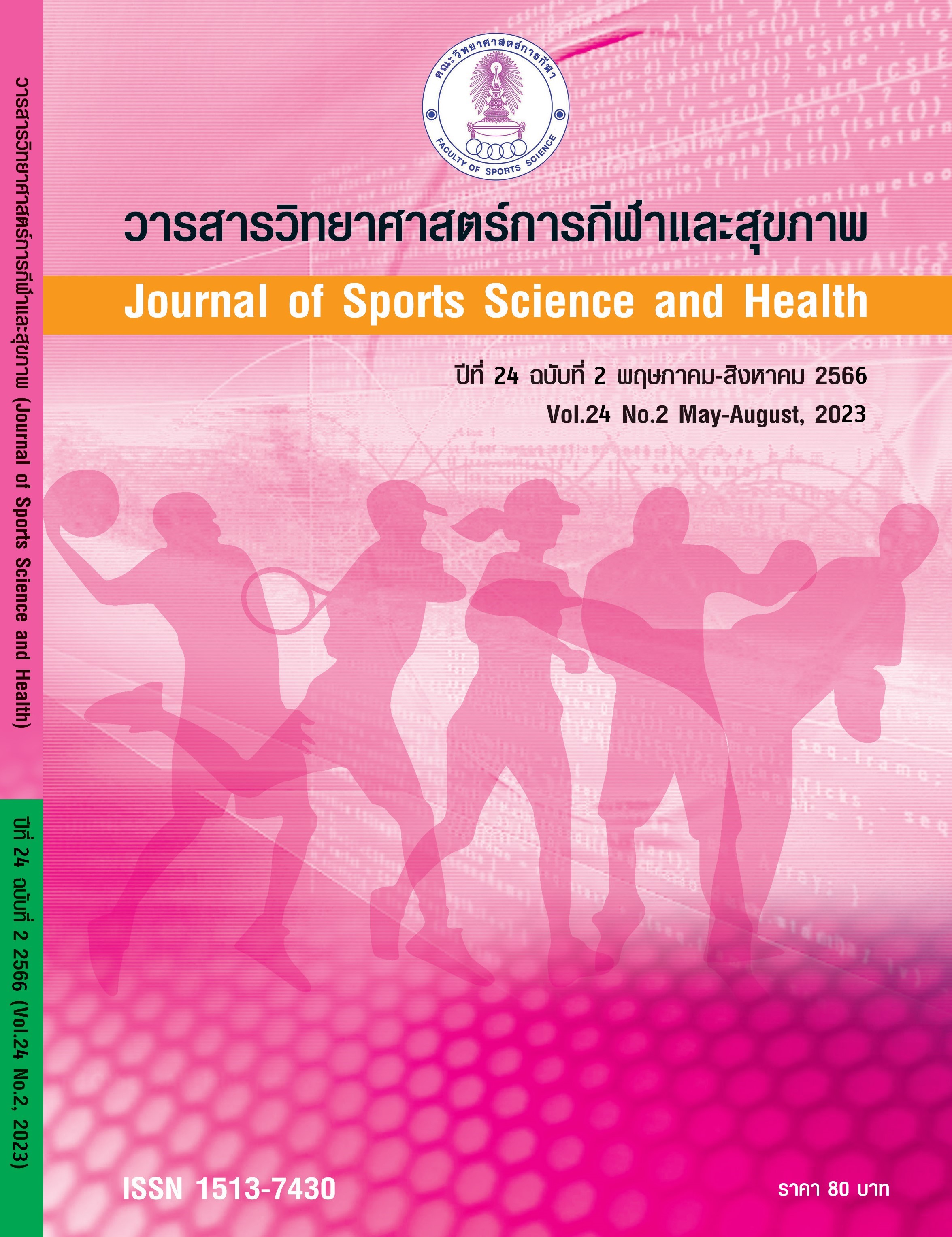SPORT CITY AND THE DEVELOPMENT OF PEOPLES QUALITY OF LIFE
Main Article Content
Abstract
This review article focuses on the concept of sports city and the improvement of quality of life. It deals with the analysis of data as a conceptual framework for the management of Physical Education classes in line with the quality of development with the content covering the following issues (1) Health promotion and exercise (2) Mass sports (3) Life history of the population (4) Sports economy (5) Advancement of technology. With this regard, sports cities can be success with the participation of the people in the province, the government sector, local government and the private sector to be leading the promotion of sports in their respective cities. In order to be a sustainable sports city, therefore they should be a place to promote the happiness of people of all ages and to play a part in enhancing the economy to develop prosperity from community to society. It also affects the quality of life of the youth and people when they enjoy and engage themselves in an enjoyable and sustainable society by engaging them to do sports.
Article Details

This work is licensed under a Creative Commons Attribution-NonCommercial-NoDerivatives 4.0 International License.
References
Baker, B.J. (2002). American Sport in the City the Making of an Urban Place. A Thesis in Master of Architecture University of Cincinnati: The School of Architecture and interior Design.
Campbell, et al. (1976). Subjective measure of well-being. American: Psychologist, 31(1), 51.
Cummins, R.A. (1998). The comprehensive quality of life scale (5"ed). Proceeding of the First International Conference on Quality of Life in Cities, Singapore, 4-6 March. p.68.
Daniel, P. and Hopkinson, M. (1990). The Geography of Settlement. Hong Kong: Oliver & Boyd.
Fisher, R. (1992). Personal Values and Individual Quality of Life in Palliative Care Patients. Journal of Pain and Symptom Management, 30, 154-159.
Kanokwan Choocheep. (2008).Quality of Work Life of Civil Servants in the Southernmost Provinces. Thesis (Public Administration). Faculty of Public Administration: National Institute of Development Administration.
Kusuma Kosol. (2012). Quality of Life of Agriculturists during the Economic Recession. A case study in Surat Thani and Nakhon Si Thammarat Provinces. Thesis (Public Administration). Faculty of Public Administration: National Institute of Development Administration.
Lee, H. et al. (1982). Perceptions of quality of life in an industrializing country: The case of Republic of Korea, Social Indicators Research, 10, 297-317.
McMahon, D.M. (2005). Happiness: a History. New York: Atlantic Monthly Press.
Ministry of Tourism and Sports. (2017). The Sixth National Sports Development Plan (2017-2021). Bangkok: Business Organization.
National Economic and Social Development Board, Office. (November 15, 2020) The Twelfth National Economic and Social Development Plan (2017-2021). Retrieved from www.nesdb.go.th.
Nesse. R.M. (2005). Natural selection and the elusiveness of happiness. In F.A. Huppert, N. Bayis & B. Keverne (Eds.), The science of well-being (pp. 3-32). Oxford: Oaford University Press.
Nipon Kantasewee. (2012). The Development of Quality of Life and Society. Bangkok: Academic Center of Royal Thai Naval Institute.
Office of the National Economic and Social Development Council. (2020). Liveable City, Liveable Community. Retrieved from http://www.nesdb.go.th/Interestingmenu/City/rightbarnew.html.
Pachong Praekhaow. (2009). Behaviors for Exercises of King Mongkut’s University of Technology Thonburi Students: A Case Study. Faculty of Mathematics and Science, King Mongkut’s University of Technology Thonburi.
Patcharee Yalaeng. (2013). Study in Quality of Life and Factors Influencing Quality of Life of Palm Oil Farming in the South of Thailand, Chiang Mai, Maejo University.
Rahim Al Zarooni A. and Falaknaz A. (2020). Dubai Sports City to life. Search on http://www.dsc.ae/who-we-arel.Ctri.
Royal Institute. (2003). Royal Institute Dictionary B.E.2542. Bangkok: Nanmee Books Publication.
Sharma. R.C. (1988). The meaning of quality of life. In R.C. Sharma, ed. Population, resource environment and quality of life. New Delhi: Dhanpat Rai and Sons.
Sports Authority of Thailand. (2020). Sports City. Retrieved from http://www.sat.or.th/index.php/en/.
Sutthipong Bunpadoong. (2011). Developing the Life Quality of the Elderly by Applying Sufficiency Economy-Based Schooling (Phase 1). Bangkok: Suan Sunandha Rajabhat University.
Sukhum Taptawee. (2011). Quality of Life in the Work of Non-Commissioned Officers: A Case Study, 2nd Engineer Battalion, Kings Guard 402: A Case Study, 2nd Engineer Battalion, Kings Guard 402: Special Problems of Graduate Students in Public Administration. Chonburi, General Administration, Burapha University.
Thailand National Reform in Sports, Arts, Culture, Morality and Ethics Board, National Reform Council (November 15, 2020). Sport City. Retrieved from https://www.parliament.go.th/ewtcommittee.
Walailuk University. (1996). The Royal Guidance of His Majesty the King Bhumibol Adulyadej at the Commencement Ceremony since 1950-1994. Nakhon Si Thammarat.
Yupa Udomsak. (2007). Concepts, Principals and Methods of Demographic Studies. In Conference Papers on the Topic Health Education. Nakhon Pathom: Mahidol University.


